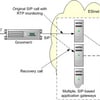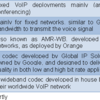In the realm of digital communications, you could say that gateways are a necessary evil.
[By the way; that’s a gateway as distinct from a router, Proxy server, or some form of gatekeeper or firewall function at an entry/exit point to the network.]
Sure, gateways aren’t wicked or malevolent – like vampires. Come to think of it, though, if it wasn’t for vampires, neither Peter Cushing nor Christopher Lee, not to mention Buffy (who polished off many a vampire), would’ve had much of a career. You’d probably think they’d be inclined to say, “Evil is good!”
So gateways are a necessary evil, which means they’re a good thing. Let’s face it, nobody buys a gateway, because they want to. Gateways are purchased because they are needed. Gateways are the vampire slayers of the netherworld of communications. Gateways are purchased, because somebody, somewhere, in their own particular universe, has a problem to solve – because they are necessary. That’s a truism (close to being a fact). But, what’s the problem?
Here’s an eccentric example. A telephone service is implemented using two tin cans and a length of string, but the string breaks; it’s been frayed or worn and cut or torn, and communication has been lost. Think of the gateway as the knot in the string that fixes the problem. If that analogy doesn’t quite work, think of the tin cans being in the hands of a call centre agent in say, Glasgow, and a customer in London – a magic gateway then helps them communicate (as neither is guaranteed to be speaking the same language, “Ye ken whit I mean?”).
And, if that still doesn’t do it for you, think of the call centre being served by an Avaya Communications Manager running SIP and the caller being on the other end of a PBX in a DPNSS network. In that scenario, the gateway solves the problem of the two parties not being able to interconnect. In fact, that’s tantamount to being a definition of a gateway.
A gateway is an appliance that is placed between two networks (or a piece of equipment and a network) that use different base protocols in order to enable communication between them by converting data and signalling from one format to another – problem solved!
In one way or another, a gateway is an internetworking device capable of joining together two networks. In a sense, by the above definition, a gateway appears at the edge of a network. However, once it’s installed, the two networks behave as one and the gateway should be no more intrusive than the knot in the string.
One example of a gateway solving real world, business problems was where a certain user’s customer premise equipment (CPE), running one particular protocol, needed to connect to a network using a fundamentally different protocol.
[For those wishing to know, the CPE was running the legacy T1 robbed bit protocol – a multi-frequency (MF) tone-based signalling protocol – and the network, to which it needed to connect, was operating a Q.931-based, primary rate, ISDN protocol, which in that particular case, was ETS 300 (aka DSS1 or Euro ISDN).]
The problem was compounded by the need for calls to be directed towards specific devices sitting behind the CPE, which could be identified only by means of ISDN sub-address data. It wouldn’t have been much of a problem if the CPE had been an ISDN-based PABX, but as so often inconveniently happens, it wasn’t.
The ‘how to’ answer for the systems integrator needing to design a solution for the end user was not to attempt to use an expensive PBX. Nor was it to redesign or adapt its own technology by adding some proprietary hardware and software; all of which would’ve consumed valuable time and resource that it didn’t have to spare. The answer was to use a gateway (in this case, Aculab’s GroomerII), which solved the two-tier problem; not only converting between the two protocols, which was a given, but also adapting the incoming call data to manipulate the outgoing call in the desired manner.
From a business perspective, the added cost of the gateway was by far the lesser of all alternative ‘evils’ and, in point of fact, the operating cost benefits of the successful outcome outstripped any concerns over the marginal, additional capital cost involved.
There are many other real world, problem solving examples involving vampire-slaying gateways. Just think of the gateway as the ‘knot in the string’ – a string of garlic if you like.
Blog by Ian Colville
[By the way; that’s a gateway as distinct from a router, Proxy server, or some form of gatekeeper or firewall function at an entry/exit point to the network.]
Sure, gateways aren’t wicked or malevolent – like vampires. Come to think of it, though, if it wasn’t for vampires, neither Peter Cushing nor Christopher Lee, not to mention Buffy (who polished off many a vampire), would’ve had much of a career. You’d probably think they’d be inclined to say, “Evil is good!”
So gateways are a necessary evil, which means they’re a good thing. Let’s face it, nobody buys a gateway, because they want to. Gateways are purchased because they are needed. Gateways are the vampire slayers of the netherworld of communications. Gateways are purchased, because somebody, somewhere, in their own particular universe, has a problem to solve – because they are necessary. That’s a truism (close to being a fact). But, what’s the problem?
Here’s an eccentric example. A telephone service is implemented using two tin cans and a length of string, but the string breaks; it’s been frayed or worn and cut or torn, and communication has been lost. Think of the gateway as the knot in the string that fixes the problem. If that analogy doesn’t quite work, think of the tin cans being in the hands of a call centre agent in say, Glasgow, and a customer in London – a magic gateway then helps them communicate (as neither is guaranteed to be speaking the same language, “Ye ken whit I mean?”).
And, if that still doesn’t do it for you, think of the call centre being served by an Avaya Communications Manager running SIP and the caller being on the other end of a PBX in a DPNSS network. In that scenario, the gateway solves the problem of the two parties not being able to interconnect. In fact, that’s tantamount to being a definition of a gateway.
A gateway is an appliance that is placed between two networks (or a piece of equipment and a network) that use different base protocols in order to enable communication between them by converting data and signalling from one format to another – problem solved!
In one way or another, a gateway is an internetworking device capable of joining together two networks. In a sense, by the above definition, a gateway appears at the edge of a network. However, once it’s installed, the two networks behave as one and the gateway should be no more intrusive than the knot in the string.
One example of a gateway solving real world, business problems was where a certain user’s customer premise equipment (CPE), running one particular protocol, needed to connect to a network using a fundamentally different protocol.
[For those wishing to know, the CPE was running the legacy T1 robbed bit protocol – a multi-frequency (MF) tone-based signalling protocol – and the network, to which it needed to connect, was operating a Q.931-based, primary rate, ISDN protocol, which in that particular case, was ETS 300 (aka DSS1 or Euro ISDN).]
The problem was compounded by the need for calls to be directed towards specific devices sitting behind the CPE, which could be identified only by means of ISDN sub-address data. It wouldn’t have been much of a problem if the CPE had been an ISDN-based PABX, but as so often inconveniently happens, it wasn’t.
The ‘how to’ answer for the systems integrator needing to design a solution for the end user was not to attempt to use an expensive PBX. Nor was it to redesign or adapt its own technology by adding some proprietary hardware and software; all of which would’ve consumed valuable time and resource that it didn’t have to spare. The answer was to use a gateway (in this case, Aculab’s GroomerII), which solved the two-tier problem; not only converting between the two protocols, which was a given, but also adapting the incoming call data to manipulate the outgoing call in the desired manner.
From a business perspective, the added cost of the gateway was by far the lesser of all alternative ‘evils’ and, in point of fact, the operating cost benefits of the successful outcome outstripped any concerns over the marginal, additional capital cost involved.
There are many other real world, problem solving examples involving vampire-slaying gateways. Just think of the gateway as the ‘knot in the string’ – a string of garlic if you like.
Blog by Ian Colville




 Technorati
Technorati Del.icio.us
Del.icio.us Slashdot
Slashdot Digg
Digg twitter
twitter




























Leave a comment